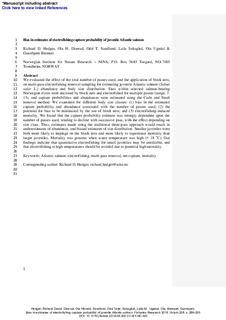| dc.contributor.author | Hedger, Richard David | |
| dc.contributor.author | Diserud, Ola Håvard | |
| dc.contributor.author | Sandlund, Odd Terje | |
| dc.contributor.author | Saksgård, Laila M. | |
| dc.contributor.author | Ugedal, Ola | |
| dc.contributor.author | Bremset, Gunnbjørn | |
| dc.date.accessioned | 2018-09-05T11:18:13Z | |
| dc.date.available | 2018-09-05T11:18:13Z | |
| dc.date.created | 2018-09-03T15:31:23Z | |
| dc.date.issued | 2018 | |
| dc.identifier.citation | Fisheries Research. 2018, 208 286-295. | nb_NO |
| dc.identifier.issn | 0165-7836 | |
| dc.identifier.uri | http://hdl.handle.net/11250/2560933 | |
| dc.description.abstract | We evaluated the effect of the total number of passes used, and the application of block nets, on multi-pass electrofishing removal sampling for estimating juvenile Atlantic salmon (Salmo salar L.) abundance and body size distribution. Sites within selected salmon-bearing Norwegian rivers were enclosed by block nets and electrofished for multiple passes (range: 7–13), and capture probabilities and abundances were estimated using the Carle and Strub removal method. We examined for different body size classes: (1) bias in the estimated capture probability and abundance associated with the number of passes used; (2) the potential for bias to be minimized by the use of block nets; and (3) electrofishing-induced mortality. We found that the capture probability estimate was strongly dependent upon the number of passes used, tending to decline with successive pass, with the effect depending on size class. Thus, estimates made using the traditional three-pass approach would result in underestimates of abundance, and biased estimates of size distribution. Smaller juveniles were both more likely to impinge on the block nets and more likely to experience mortality than larger juveniles. Mortality was greatest when water temperature was high (> 18 °C). Our findings indicate that quantitative electrofishing for small juveniles may be unreliable, and that electrofishing at high temperatures should be avoided due to potential high mortality. Atlantic salmon Electrofishing Multi-pass removal Net capture Mortality | nb_NO |
| dc.description.abstract | Bias in estimates of electrofishing capture probability of juvenile Atlantic salmon | nb_NO |
| dc.language.iso | eng | nb_NO |
| dc.rights | Attribution-NonCommercial-NoDerivatives 4.0 Internasjonal | * |
| dc.rights.uri | http://creativecommons.org/licenses/by-nc-nd/4.0/deed.no | * |
| dc.subject | Atlantic salmon | nb_NO |
| dc.subject | Electrofishing | nb_NO |
| dc.subject | Multi-pass removal | nb_NO |
| dc.subject | Net capture | nb_NO |
| dc.subject | Mortality | nb_NO |
| dc.title | Bias in estimates of electrofishing capture probability of juvenile Atlantic salmon | nb_NO |
| dc.title.alternative | Bias in estimates of electrofishing capture probability of juvenile Atlantic salmon | nb_NO |
| dc.type | Journal article | nb_NO |
| dc.type | Peer reviewed | nb_NO |
| dc.description.version | acceptedVersion | nb_NO |
| dc.rights.holder | © 2018 Elsevier B.V. All rights reserved. | nb_NO |
| dc.subject.nsi | VDP::Zoologiske og botaniske fag: 480 | nb_NO |
| dc.subject.nsi | VDP::Zoology and botany: 480 | nb_NO |
| dc.source.pagenumber | 286-295 | nb_NO |
| dc.source.volume | 208 | nb_NO |
| dc.source.journal | Fisheries Research | nb_NO |
| dc.identifier.doi | 10.1016/j.fishres.2018.08.005 | |
| dc.identifier.cristin | 1606354 | |
| dc.relation.project | Egen institusjon: Norwegian institute for nature research (NINA) | nb_NO |
| dc.relation.project | Andre: Environmental Agency in Norway | nb_NO |
| cristin.unitcode | 7511,3,0,0 | |
| cristin.unitname | Avdeling for akvatisk økologi | |
| cristin.ispublished | true | |
| cristin.fulltext | postprint | |
| cristin.qualitycode | 1 | |

